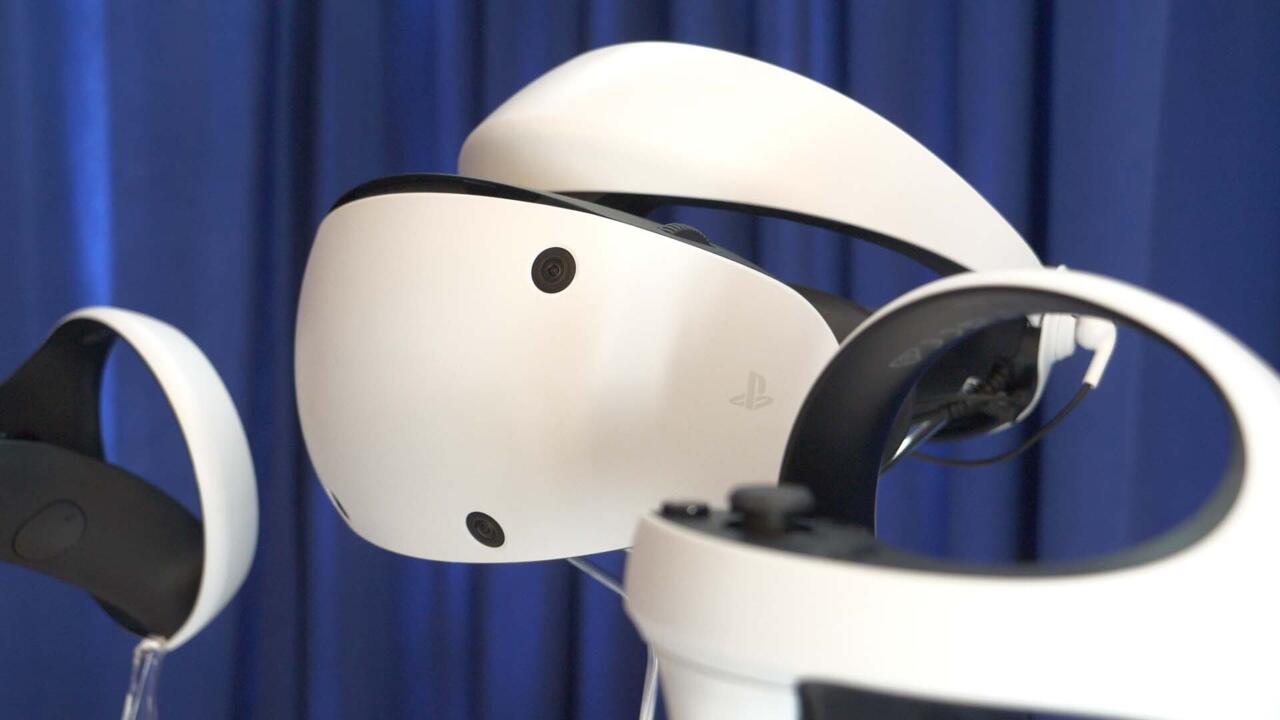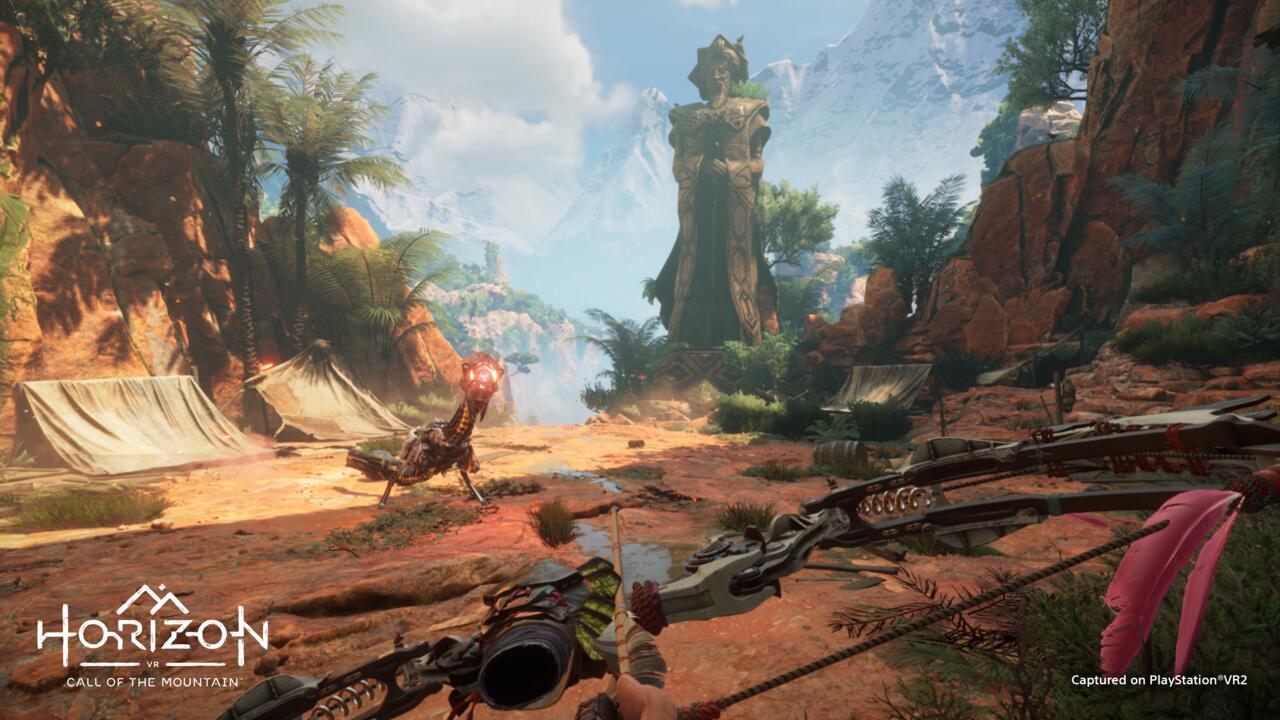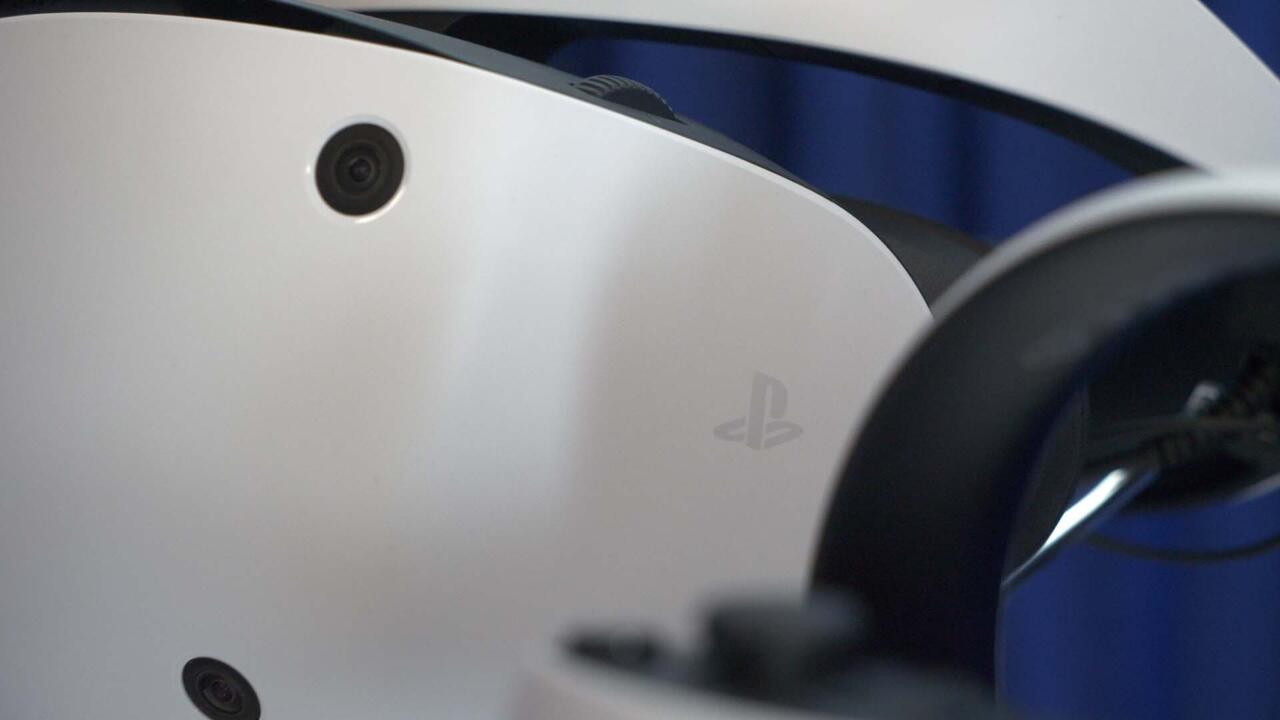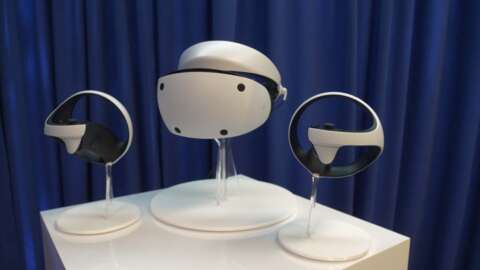The opening of my Horizon Call of the Mountain demo for PlayStation VR 2 was a genuine "Welcome… to Jurassic Park" moment. It caught me by surprise because, honestly, I've cooled off on VR quite significantly. For a while, VR was all anyone could talk about--an exciting evolutionary step for gaming. But its momentum dissipated, and its ubiquity took it from being the conversation to just part of a conversation, and a relatively small one at that. Between Valve's Index, HTC's Vive, and Oculus' lightweight, cordless Quest 2, VR not only became a reality, but an affordable and convenient one.
All this is to say that, in a relatively short period of time, VR went from an exciting future to an ordinary present and, in many ways, lost its luster in the process. Now, VR headsets are just another entertainment device vying for your time, attention, and money. But what hasn't changed is the potential that made VR so exciting in the first place, which largely remains unfulfilled. So, the task now becomes doing it better and hoping that small steps of iteration can be as meaningful in realizing that potential as the giant leaps of innovation that created it.
Iteration is very much the name of the game when it comes to PSVR 2. It's a piece of hardware that uses Sony's own learnings, as well as what it has seen competitors do, to inch the technology forward. It features better displays, utilizes more powerful hardware, and improves the overall user experience. And that doesn't sound like much, but it's enough to experience a game with a level of intimacy that's not possible when holding a controller and sitting a few feet away from a screen. With PSVR 2, Sony's goal seems to be to push that sense of immersion much deeper.
A core strength of PSVR 2, like its predecessor, is that it is powered by a PlayStation console. The difference now is that said console--PlayStation 5--is markedly more powerful than what the original PSVR had to work with. As a result, the distinction between VR experiences that you can have on a PSVR 2 and most other headsets is much more noticeable, which brings us back to that Jurassic Park moment.
A New Horizon
Horizon Call of the Mountain is an impressive showpiece that makes compelling cases for pretty much every new hardware design and engineering choice made for the PSVR 2. The game is set in the same universe as Aloy's adventures, but players are cast as Ryas, a Shadow Carja who, for some reason, has been busted out of prison. The gameplay demo I played began with a boat ride where I learned that Ryas was being taken to Dawn's Grasp, which he didn't seem too happy about. But while my escorts bickered among themselves, I was completely enthralled by the world.
Sony has touted much higher visual fidelity for PSVR 2, which, for the tech-spec obsessed people out there, amounts to an OLED display that offers a resolution of 2000x2040 per eye, HDR, refresh rates of 90Hz and 120Hz, and a 110-degree field of view. This is all impressive on paper, but when you experience it with the headset on, it's a bit of magic.
The level of detail on display was genuinely overwhelming, mostly because I didn't expect it from a VR game. I know how dismissive that sounds of all the VR games out there, of which there are certainly more than a few impressive-looking ones. However, there's a clear line between the way a VR game and a non-VR game look--there's a level of richness, detail, and polish that separates the two. Horizon Call of the Mountain blurs that line on PSVR 2.

While I sat on the boat, I marveled at the emerald green water beneath me that gently rippled as we drifted through it; the leaves serenely drifting by, carried by invisible air currents; the thick green foliage layered on top of rocky outcroppings that had a golden glow where the sun was able to push through the thicket of trees. Along the river's snaking path, the protruding branches gave way to a clearer view of towering cliff faces and, in the distance, snowy mountains beneath a brilliant blue sky. All of it was rendered in sharp, high resolution with finite details clearly visible--it looked like a PS5 Horizon game. Sure, in a side-by-side comparison Horizon Forbidden West is likely to look noticeably better, but the point is that this PSVR 2 game looks good enough to evoke the comparison to a PS5 game instead of, well, a VR game.
There were so many flourishes to soak in: colorful flowers, rushing waterfalls, and leaves bobbing on the surface of the water, but it was hard not to fixate upon Horizon's iconic machine animals, which I got to see from a brand-new perspective. From the distance came the roar of a Stormbird and I whipped my head around to look in the direction of the sound to see the avian behemoth swoop down, the taller trees brushing through its mechanical underbelly. Its flyby kicked up the loose leaves into a frenzy, as it majestically swooped around a rocky tooth and soared out of sight.
Still processing how impressive a sight that was, my lowering gaze was met with Grazers standing at the bank of the river, watching nervously as we got closer. Taking action, one of them bounded over the river, but the others either indulged their curiosity and watched us pass by or simply paid us no mind and trotted alongside the boat, eventually peeling off to head into the jungle. The real jaw-dropper, however, was the sudden appearance of a Tallneck. Those who have played the Horizon games will know that these machines are massive in scale and, from the third-person perspective, they are magnificent to behold. But when you're underneath one, looking up at a Tallneck from the first-person perspective as it absentmindedly steps over you, there's a whole different level of appreciation for the stature of these beasts.
It can feel a bit corny to wax poetic about how amazing and cool and awe-inspiring it all is, and you may even be rolling your eyes while reading this. But for me, the magic of VR is how disarming it can be; how even the most cynical people can be won over by the sense of wonder and disbelief that VR is uniquely positioned to inspire. The satisfaction of it comes from giving yourself over to that feeling of having your senses tricked into thinking you're somewhere fantastical is what originally drew me to VR, but as the months went by and it became ordinary, that sensation dulled--I got used to it. However, in just a few moments with PSVR 2 it all came flooding back. I'll probably feel less effusive about it in time, but right now I'm excited by the potential again, and I suspect PlayStation's hope is that talented developers and gamers feel the same.
Eyes On The Prize
One of the major features that facilitates high-fidelity VR experiences such as Horizon Call of the Mountain is foveated rendering. This is a feature that is available on other devices, including Quest 2, but what makes PSVR 2's implementation different, according to Sony, is that it's coupled with eye-tracking. This means that the PS5 and PSVR 2 headset can focus on rendering where the player is looking in the highest quality while reducing the resolution and requisite processing power spent on everything in the periphery. As your eyes move around the screen, adjustments are made to ensure that wherever your focus is placed is always looking as good as it can. The end result of this is that games are significantly more detailed, and foveated rendering lets the PS5 do this without taking a hit in performance. It's an impressive bit of technology that invites developers to get more ambitious and affords them the runway to do it.
Having avoided getting stomped on by the Tallneck, I ran afoul of a Snapmaw, a crocodile-like machine that managed to tip our boat over. Thankfully, the dock was close by and all I needed to reach safety was climb a ladder; the perfect opportunity to get to grips with the new PSVR 2 Sense controller. The original PSVR utilized Move controllers that were initially released for the PlayStation 3. While Sony managed to make aging motion controllers work for it, they were noticeably lacking when compared with contemporary VR controllers. That is no longer the case with the Sense, which has all the features you'd expect from a modern VR controller along with a few borrowed from the PS5's DualSense.

The highlights include finger-detection, which allows players to interact with the world around them in a more natural way. That's coupled with tracking that lets the headset follow where you are moving the controller in the space around you. These two features alone make the VR Sense controller a huge step up from Move, as they work in tandem to allow players to do finger guns, which I did.... constantly. Of course, you can also use the Sense controllers for climbing, which is a big part of Horizon Call of the Mountain's gameplay. By essentially mapping your physical hands to the virtual ones on-screen, then using haptic feedback and adaptive triggers that vary force and tension depending on what you're doing, interactions feel tactile. I was able to move my hands close to each rung of the ladder, grip down using the buttons on the controller, and then physically replicate the motion of pulling myself up to have Ryas do the same in-game. I got a handle on how to clamber around Horizon Call of the Mountain's world so quickly that, before I knew it, I was scaling up the sides of cliffs and shimmying across dangling ropes with ease.
Given the time constraints on my demo, I wasn't able to get a feel for how this experience holds up over an extended period of time, or whether it gives way to the feeling of roteness. It is very much possible that I'd eventually tire of all this, especially given that Call of the Mountain is multiple hours long, but with any luck, developers will keep things varied. Unlike the first PSVR, which felt like it was being held back by the Move and DualShock controllers, the Sense controllers are poised to present opportunities instead of limit them.
As my confidence in using the Sense controller grew, so did the speed at which I was able to get around in the game. It wasn't until I casually glanced behind me that I realized how immersed in the process I had become. That over-the-shoulder peek made the hair on the back of my neck stand up as I faced what looked like a perilous fall to my death. In that moment I was convinced that I was actually there and a single mistake would be the end of me. From that point on, I was decidedly more careful and considered.
The fact that, even with my extensive experience in VR, my senses and reason could be overcome by how the world looked and how convincing my place in it felt, was a strong case for the power of a compelling VR gaming experience. More importantly, for me, it was a much-needed reminder of why VR is a frontier still worth exploring.
Sense-ational
The rest of the Horizon Call of the Mountain demo was spent getting more acquainted with the controllers and how they are used for gameplay. One of my favorite touches involved holding a face button on both controllers and then moving my arms up and down to simulate walking. It doesn't sound particularly exciting and is something that has been experimented with in other games, but it's my preferred way of moving around VR worlds. In Call of the Mountain it felt like a very intuitive middle-ground between the nauseating direct movement option and the immersion-breaking teleport method. I played through the entire demo without getting that lightheadedness that comes from moving in-game while standing still in the real world.

While walking around, I was able to freely move around, as well as pick up and inspect pretty much everything in my surroundings. During the boat trip, I noticed a broken arrow floating in the water, so I leaned over the side and plucked it out of the water, inspecting it briefly before tossing it into the air with one hand and then catching it with the other. Later, while investigating an abandoned camp, I found some juicy-looking apples, which I scooped up and raised to my mouth to eat and recover health. At one point I yanked off the lid of a barrel using a handle and began pretending I was Captain America with a shield--eventually throwing it into the distance. Sadly there weren't any enemies about to test my ricocheting skills.
When I did encounter an enemy, it was a Watcher, traditionally thought of as the easiest enemy to fell in the Horizon games. However, in Call of the Mountain, taking one down was no easy task, given the level of physicality and quick reactions required. Watchers are small, agile, and very aggressive, so defeating it was a case of making use of short openings to raise my hand over my shoulder to grab and notch an arrow, draw the bowstring, and fire off a shot--there wasn't an on-screen crosshair, so accuracy was down to eyeballing it.
In combat scenarios, movement is restricted to a predefined path. However, instead of running along it, players are required to hold two face buttons, swing their arms either left or right, and release the buttons as the motion is completed to execute a step-dodge. By repeatedly doing this, I was able to circle around enemies in order to give myself space and get into a more advantageous position. Should an enemy manage to get in close and leap or swipe at you, it's also possible to physically crouch to get out of the way.
This particular technique was essential to taking on the Thunderjaw--a much bigger and scarier enemy than the Watcher. I was only able to briefly play this fight in a specific arena-based setting, but it was intense. The Thunderjaw towered above me and was very intimidating. It had a variety of attacks, including a tail whip, balls of electricity, and a machine gun, which required quick movements to avoid. And all the while I was keeping a close eye on the machine to find the brief moments where I could fire an arrow into its weak point. Sadly, as I started to get the hang of fighting the Thunderjaw, the demo session came to an end.

What stood out to me about playing Horizon Call of the Mountain was how it felt like an amalgamation of the different kinds of VR gaming experiences we're familiar with. It was part virtual tourism, part climbing sim, part bow-and-arrow combat game, and a bit of that goofing off with object physics, all in one. These are all things I've done in various ways plenty of times before, but having it combined into one cohesive experience that looks as good as Horizon Call of the Dawn elevated it all. It might seem a bit superficial to be so focused on aesthetics and visual fidelity, but I think that's foundational to having a memorable VR gaming experience.
Take ILMxLAB's Star Wars: Tales from the Galaxy's Edge, for example. What I played of it was fairly rudimentary from a gameplay standpoint. I walked around, shot some phasers, and threw a grenade or two, but what made all that more interesting was the fact that I had just spent some time in a Cantina, chatting to a strange-looking alien bartender about the various exploits that he has been regaled with by patrons, and then being assigned my own little adventure to go out on. According to its developer, this game is going to be made up of a bunch of smaller stories, all told by this bartender, that will cast players as Jedi, Bounty Hunters, and more, sending them off to different corners of a galaxy far, far away. Having felt how cool it was to be in an empty Cantina, where I was able to play a version of darts with rocket-powered projectiles, get up close and personal with strange look aliens--all who had very detailed character models--and admire the adventure-worn Millennium Falcon docked just outside, and trade fire with enemies in the dusty desert area outside, I can't wait to see the other places in the Star Wars universe I'll be able to travel to.
I also got hands-on time with Resident Evil Village, which felt a lot like the excellent implementation of VR used for Resident Evil 7. A lot of it was a similar experience, but that's not to undersell how impressive it was to stand in Castle Dimitrescu, where I could get up close and personal with the gothic architecture and, yes, Lady Dimitrescu herself. Let's just address the elephant in the room: The gaming world as a whole was hit with a severe case of the hornies when the nine-foot villainess made her debut, and I fully expect the same thing to happen again when people learn they can throw on a headset and have her towering above, admonishing them for being a pathetic little man thing or whatever--just don't try and lay down and see if she will step on you, as you'll just fall through the floor. Don't ask me how I know.
Extreme thirst opportunities aside, Resident Evil Village in VR benefitted from the increased visual fidelity, particularly as it accentuated the unnerving atmosphere. Horror games in particular benefit from the VR treatment, making players feel oppressed and--at times--like they're in life-threatening danger, which is exactly what it felt like when Bella, Cassandra, and Daniela materialize out of thin air and you're dragged around the castle like a child's stuffed animal. Surprisingly, that didn't make me dizzy, but the smoothness of simply walking around did, so your mileage will still vary when it comes to VR sickness based on this demo.
Dressed To Impress
Even at this early stage, it seems clear PSVR 2 will be capable of powering impressive games, but perhaps what I'm most excited about is knowing that I'll be able to play them on a headset that feels comfortable and delivers a good user experience. The original PSVR is easily the most comfortable of the various VR headsets on the market, and I believe that most will feel the same about the PSVR 2. Not just because of the ergonomics of the device, but because Sony has made a few tweaks to allow players to customize how the device sits on their head, as well as how they see through it. The new lens adjustment dial is perhaps the biggest thing to call out, as it allows people to tweak the spacing of the lens to match your own eye positions. Another small touch that I didn't notice until the very end was the complete lack of fogging, which is an issue that I often have with VR headsets as someone who runs quite hot. Sony has added a vent to the PSVR 2 to allow air to flow to the lenses, reducing the buildup of fog and ensuring the screens remain clear.

The four cameras on the PSRV 2 headset, along with the ever-crucial inside-out tracking this enables, means users will be able to press a button on the bottom of the device to give themselves a clear view of their surroundings. That might not sound too exciting, but speak to anyone who uses VR headsets a lot and they'll tell you how important it is to be able to quickly take a look at what's going on around you. While most other devices require you to take them off, or provide a weird, barely intelligible representation of your environment, PSVR 2 lets you quickly and easily swap between video game and real world. During the demo I was able to hit the button and then pass controllers back and forth with others, instead of stumbling around trying to sense where people were or taking the headset off entirely. It's a small thing that just makes the whole experience of being in VR more comfortable and convenient.
Similarly, PSVR 2 also remedies one of the major other criticisms people had of the original hardware: its messy and cumbersome setup. For PSVR 2, Sony has consolidated everything down to a single cable that can be connected to the front of the PS5. Despite being tethered to the console, I didn't have any issues with the cord getting in the way and, similar to Oculus' devices, players can define a play area around them and the PSVR 2 will ensure they're not overstepping and toppling over tables or kicking pets. The aforementioned ability to quickly look at your surroundings also alleviates any worries that you might get caught slipping--literally. It’s worth bearing in mind that I was in a testing environment that was very sparse, so I can’t account for how the passthrough visuals or any of the other tracking functions are impacted in more natural environments that usually have furniture, pets, and other people in closer proximity.

When all was said and done, I ended my time with PSVR 2 with much more of an interest in it than when the hardware was initially announced. Horizon Call of the Mountain, admittedly, didn't do anything particularly novel, but it served as a visual benchmark for the kind of experience a AAA team with the backing of a big publisher can achieve in these early stages, and it was certainly impressive. The best part of VR as a technology is what creative people can do when they are able to tinker in an open ecosystem--that freedom is how some of the coolest things on the Quest 2 and other VR devices have come to fruition. Although everything on PS5 will exist in Sony's walled garden, at least this time around the grass is looking much greener for those who want to play there.
As previously mentioned, PSVR 2 feels like an iteration on the original, which should come as no surprise. However, what I learned from my first experience is that these small, smart tweaks and additions are more significant than they may seem. At a time when virtual reality feels like old news, PSVR 2 feels poised to be a shot in the arm for it in the gaming space. It remains to be seen whether PSVR 2 will garner widespread interest, but at the very least I'm more confident that it'll take us one step closer to realizing its full potential. Yes, a lot of what made it impressive for me was centered around visual fidelity, but seeing is believing, and in VR the possibilities for what you can see are endless.

